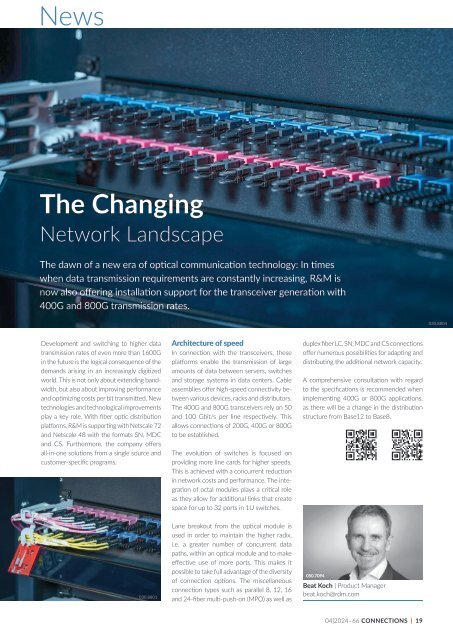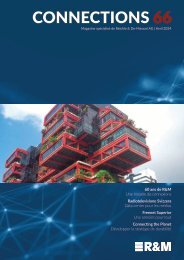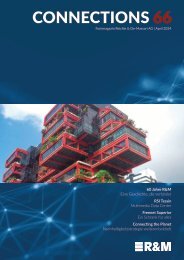CONNECTIONS_66-e
Specialist Magazine CONNECTIONS no. 66
Specialist Magazine CONNECTIONS no. 66
Create successful ePaper yourself
Turn your PDF publications into a flip-book with our unique Google optimized e-Paper software.
News<br />
The Changing<br />
Network Landscape<br />
The dawn of a new era of optical communication technology: In times<br />
when data transmission requirements are constantly increasing, R&M is<br />
now also offering installation support for the transceiver generation with<br />
400G and 800G transmission rates.<br />
030.8804<br />
Development and switching to higher data<br />
transmission rates of even more than 1600G<br />
in the future is the logical consequence of the<br />
demands arising in an increasingly digitized<br />
world. This is not only about extending bandwidth,<br />
but also about improving performance<br />
and optimizing costs per bit transmitted. New<br />
technologies and technological improvements<br />
play a key role. With fiber optic distribution<br />
platforms, R&M is supporting with Netscale 72<br />
and Netscale 48 with the formats SN, MDC<br />
and CS. Furthermore, the company offers<br />
all-in-one solutions from a single source and<br />
customer-specific programs.<br />
Architecture of speed<br />
In connection with the transceivers, these<br />
platforms enable the transmission of large<br />
amounts of data between servers, switches<br />
and storage systems in data centers. Cable<br />
assemblies offer high-speed connectivity between<br />
various devices, racks and distributors.<br />
The 400G and 800G transceivers rely on 50<br />
and 100 Gbit/s per line respectively. This<br />
allows connections of 200G, 400G or 800G<br />
to be established.<br />
The evolution of switches is focused on<br />
providing more line cards for higher speeds.<br />
This is achieved with a concurrent reduction<br />
in network costs and performance. The integration<br />
of octal modules plays a critical role<br />
as they allow for additional links that create<br />
space for up to 32 ports in 1U switches.<br />
duplex fiber LC, SN, MDC and CS connections<br />
offer numerous possibilities for adapting and<br />
distributing the additional network capacity.<br />
A comprehensive consultation with regard<br />
to the specifications is recommended when<br />
implementing 400G or 800G applications,<br />
as there will be a change in the distribution<br />
structure from Base12 to Base8.<br />
030.8801<br />
Lane breakout from the optical module is<br />
used in order to maintain the higher radix,<br />
i.e. a greater number of concurrent data<br />
paths, within an optical module and to make<br />
effective use of more ports. This makes it<br />
possible to take full advantage of the diversity<br />
of connection options. The miscellaneous<br />
connection types such as parallel 8, 12, 16<br />
and 24-fiber multi-push-on (MPO) as well as<br />
050.7094<br />
Beat Koch | Product Manager<br />
beat.koch@rdm.com<br />
04|2024–<strong>66</strong> <strong>CONNECTIONS</strong> | 19
















